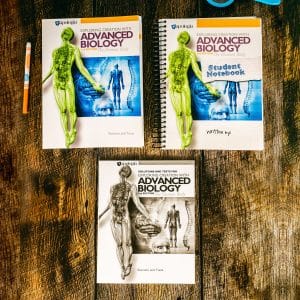Description
Take your studies with you with Apologia’s high school elective course, Exploring Creation with High School Astronomy eBook available on Apple Books. This is part of Apologia’s award-winning homeschool science curriculum for high school students. This high school astronomy eBook travels through our universe making connections for students to contemplate without the pressure of exams that core science materials require.
This course was designed as an elective for high school students in 9th – 12th grades. All you need to complete this course is this All-in-One Student Textbook and Workbook. There is no separate Student Notebook. As there are no labs or exams with this course, it should not be used to replace biology, chemistry, or physics courses that are typically studied in the high school years. Rather, it was specifically written to expand a student’s knowledge of topics typically not taught in high school. As such, its easily read, conversational style can enhance a student’s high school studies without additional burden.
Prerequisite Information
There are no prerequisites for this course.
Some of the scientific reading is backed by the mathematical equations that support it. Within the text, the author works out every mathematical explanation in great detail so that the student can follow along without needing the actual math skills. For students who are ready for the math, the author includes On Your Own comprehension questions. Detailed answers for all of the On Your Own Questions are provided in the back of the textbook so that students have all of the materials they need to succeed.
What’s Inside Exploring Creation with High School Astronomy?
Exploring Creation with High School Astronomy has 14 modules. The modules are ~25 pages long, on average. As there are no labs or exams, students are expected to read the text and complete the On Your Own questions to ensure they have comprehended the materials. A student could easily finish the course in a semester, reading one module per week. This would be a 14-week course plan. However, it is also acceptable that a student would plan to read through a module every two weeks at his or her leisure. This would make a 28-week course.
Included in Each Module You Will Find:
- On Your Own questions to allow students to self-check their comprehension along with detailed answers
- “Universal Truths” section at the start of each module, which sets the tone for what students will learn in that module
- “Where Do We Go From Here” section to wrap up the lessons learned and see the path forward
- “Think About This” callout boxes that connect the textbook facts to real-life lessons
Topics Covered in This Homeschool High School Astronomy Course
Exploring Creation with High School Astronomy is a journey that starts with the mysteries of the universe.
What are space, matter, antimatter, cosmic rays, dark matter, dark energy, black holes, and wormholes? It goes back in time to investigate the history of astronomy. What did the early stargazers see and understand? How did technology advance what we see and investigate? How does that technology work? And how does this change our model of our solar system and our knowledge of the universe? It then investigates the science of our Sun, planets, and other astronomical objects that reside in our solar system, galaxy, and the universe. It ends with a lesson on celestial navigation, learned from stargazers long ago but still a valuable tool today.
Specific topics include:
- Space and Interstellar Space
- Normal Matter, Antimatter, and Dark Matter
- Black Holes and Wormholes
- The History of Astronomy
- Astronomical Measurement
- The Model of Our Solar System
- The Sun and The Electromagnetic Spectrum
- The Inner Planets
- Orbital Mechanics
- The Moon
- Types of Telescopes
- The Outer Planets
- Dwarf Planets and the Asteroid Belt
- Stars and Constellations
- Galaxies
- Celestial Navigation
What Are the Qualifications of the Author?
Damian R. Ludwiczak is the author. He is the Chief of the Mechanisms and Tribology Branch at NASA Glenn Research Center. Damian holds a Bachelor of Science degree in Aerospace Engineering and a Master of Science degree in Engineering Mechanics. An avid space enthusiast and entrepreneur, Damian has spent most of his life contemplating the universe and its mysteries. Since 1987, he has worked as an aerospace engineer and has held numerous technical positions as a NASA employee. Damian has also held technical management positions such as the Deputy Chief Engineer for the Artemis spacecraft, Chief Engineer for the Space Launch Vehicle payload fairing system, as well as his current role as Chief of the Mechanisms and Tribology Branch. He has received numerous NASA achievement awards, including the Exceptional Achievement Medal and Outstanding Leadership Medal.
Purchase on ApplePurchase on Amazon








